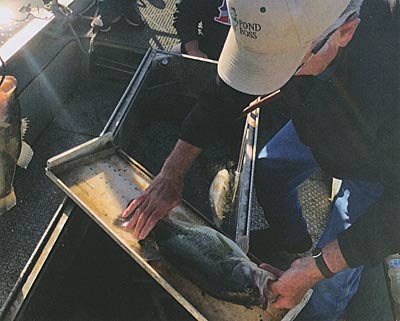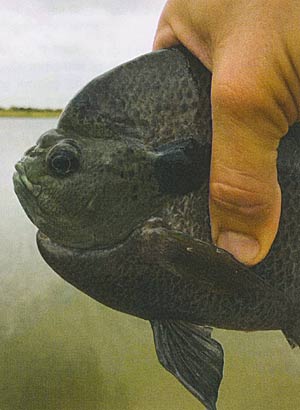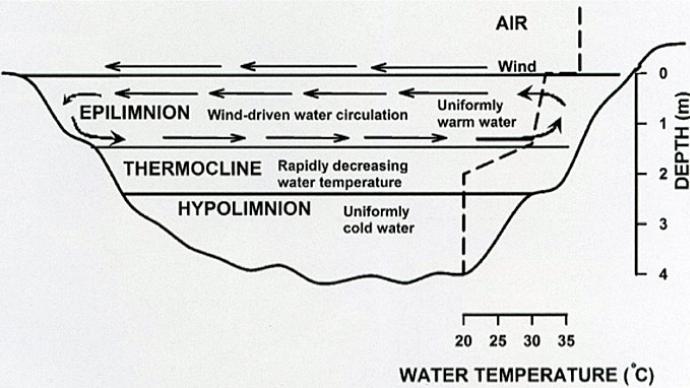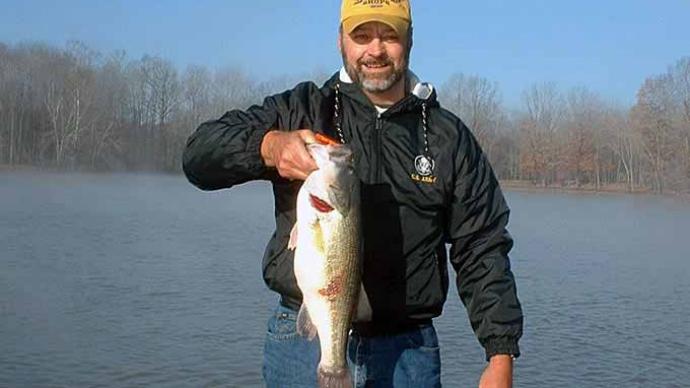
Fall followed by winter is an interesting time at the lake from a biological perspective. Many people think of that time of year as a period of rest. In reality, for many pond creatures, it is a period of frenzy followed by survival. A good way to view the workings of a pond, or for that matter a fish, is like that of an engine. A pond is similar to an engine as it is dependent on sunlight for power and nutrients for growth. The concept of bioenergetics, the flow and transformation of energy, is used in studies to quantify all types of pond life. Obviously, in fall and winter, the sun's energy in this part of the world slows and reduces to low levels so the engine slows, and with it all pond life activity. However, in the fall lead-up to winter there is a frenzied attempt to secure energy reserves.
Understanding the role of energy as it works through biological processes is fundamental to evaluating winter survival in fish. The ability to harness energy both currently and through energy stores (fat and muscle) is critical for winter survival. All pond life is dependent on energy transformations; animals must consume and use organic compounds. These are mostly carbohydrates, fats (lipids), and proteins (muscle). The amount of energy actually obtained is lower than the amount present in the food as some is used in digestion, metabolism, and thermogenesis. In short, energy put into a fish for example, equals outputs (energy used) plus growth (part of which is energy reserves).
Fish are cold-blooded, making temperature a critical factor in all biological aspects. Because they are cold blooded, warmwater fish grow during warm spring and summer waters, and as the water cools in fall, metabolism slows, and feeding and growth slow substantially. If not enough energy reserves of the right type are stored going into cold periods, fish have a difficult time. Lack of adequate food resources is the most common reason for slow growth and lack of energy reserves in many fisheries. Increasing food intake, with very little energy used by the fish, especially during the fall feeding frenzy period is good—more energy acquired and less used equals more growth and better energy reserves for winter survival.
Cold Tolerance and Fatty Acid Composition of Striped Bass, White Bass, and Their Hybrids, Anita M. Kelly and Christopher C. Kohler in North American Journal of Aquaculture 61:278-285, 1999, American Fisheries Society provides insight into how fish biology is affected by cold. Cold can affect fish in two ways, rapidly through sudden temperature drops or over time by exhausting the fish's energy reserves (starvation).
Different species of fish differ in their ability to use fat deposits. This in turn affects the temperature range in which different species can grow and survive. For example, Nile tilapia do not store excess lipids in the muscles but rather rely on visceral deposits that it is incapable of using at low temperatures, which results in high mortalities when water cools. However Common carp, which are capable of using lipids from muscular and visceral deposits, are able to survive much colder temperatures under similar conditions. It is believed that the lipid composition in the fish muscle plays a vital role in the ability of fish to adapt from one temperature to another. First, temperature determines the rate of chemical reactions, and secondly, temperature dictates the point of balance between the formation and disruption of the macromolecular structures in biological membranes. Structural flexibility, therefore, is a requirement for integrity of biological membranes. Cold temperatures constrain this flexibility. The fat apparently hardens in the colder water, causing the fat-impregnated muscles to stiffen and the fish to become exhausted and lose movement followed by death. Fish during prolonged periods of cold use up lipid and muscle reserves and starve.

The above study noted that one experiment obtained nearly 100% survival of striped bass overwintered in cages in freshwater ponds in Maryland. However, striped bass reared in cages in in New York had high mortality rates that were attributed to low water temperatures during the fall and winter. Producers raising hybrid striped bass in cages have reported sudden losses of hybrids when the water temperature rapidly decreased by several degrees in a relatively short period of time. The rapid onset of cold temperatures has been reported as the cause of death in several species of fish.
In this research paper, hybrid striped bass, subjected to a simulated cold front, which were fed prepared diet (pellets) suffered high mortality (50-90%), whereas the groups fed the natural diet (fatheads) experienced zero mortalities. This was due to the type of lipids contained in the prepared food.
In another paper, data and analyses supported the hypothesis that larger yearling smallmouth bass survive their first winter better than smaller ones. Others discovered a similar relationship between length and overwinter survival for wild fingerling brook trout, and found that first-winter mortality of young Atlantic salmon in a hatchery was largely determined by size within a year class. These losses were a result of the smaller fish not having enough stored food reserves to survive a long cold winter.
Of course, it depends on location and the type of fish involved. Bluegills, in one report, consumed very little food during the winter in more northern climates. The average stomach, in one review, contained limited amounts of plankton. Foods consumed were predominantly aquatic insects in early winter, changed to plankton in midwinter, and tended again toward aquatic insects as spring approached. Prolonged periods of warm weather resulted in an increased rate of food consumption. Yellow perch (a cool water fish) ate much more food than did bluegills (warmwater fish) during the winter. Young bluegills constituted the great bulk of the Yellow perch diet, over 60 per cent of the total volume throughout the winter. Small aquatic crustaceans were eaten in substantial numbers in midwinter. Winter predation by Yellow perch on young bluegills was an important factor in regulating the bluegill population. In another study Largemouth bass, in order to stay healthy and survive in waters where their primary prey undergoes large fluctuations in seasonal abundance (like tilapia and shad), maximize food intake in the fall, store fat, minimize activity and metabolic demands, and undertake some winter feeding in warmer lake areas.
You can see a few patterns from these studies. Eating enough of the right foods in the fall to store energy reserves is critical. Limited feeding during warming periods during winter is used by many species as a survival method.
Fish intolerant of cold temperature are slowed down by cool water and are preyed upon by more winter-capable species. Winter feeding patterns and winter starvation of small young fish have very real impacts on the type and balance offish species populations in a lake. So, management observations don't take a rest when it starts cooling down. For a healthy pond keep an eye open for fall's feeding frenzy and winter's survival status.
Reprinted with permission from Pond Boss Magazine



